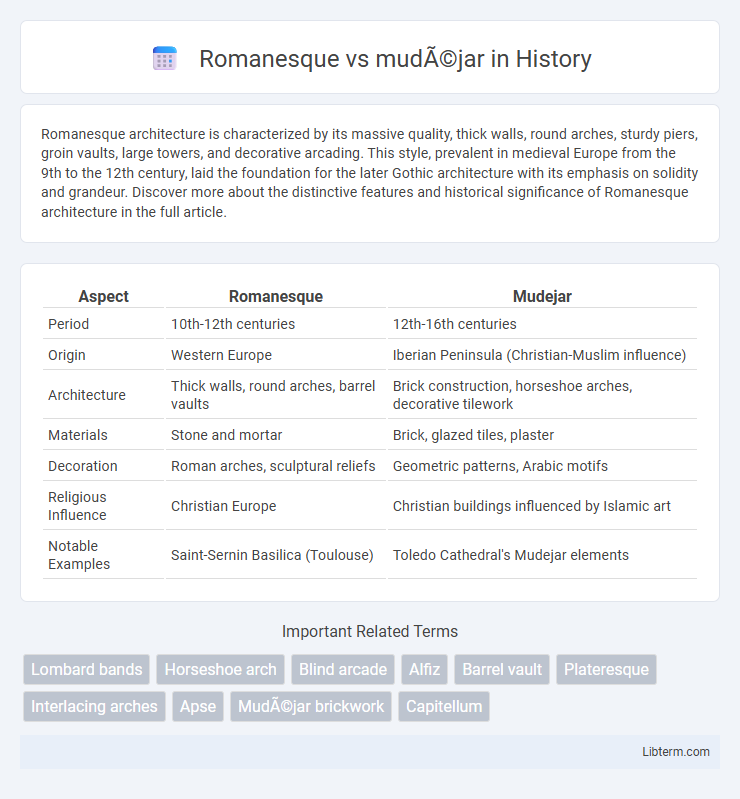Romanesque architecture is characterized by its massive quality, thick walls, round arches, sturdy piers, groin vaults, large towers, and decorative arcading. This style, prevalent in medieval Europe from the 9th to the 12th century, laid the foundation for the later Gothic architecture with its emphasis on solidity and grandeur. Discover more about the distinctive features and historical significance of Romanesque architecture in the full article.
Table of Comparison
| Aspect | Romanesque | Mudejar |
|---|---|---|
| Period | 10th-12th centuries | 12th-16th centuries |
| Origin | Western Europe | Iberian Peninsula (Christian-Muslim influence) |
| Architecture | Thick walls, round arches, barrel vaults | Brick construction, horseshoe arches, decorative tilework |
| Materials | Stone and mortar | Brick, glazed tiles, plaster |
| Decoration | Roman arches, sculptural reliefs | Geometric patterns, Arabic motifs |
| Religious Influence | Christian Europe | Christian buildings influenced by Islamic art |
| Notable Examples | Saint-Sernin Basilica (Toulouse) | Toledo Cathedral's Mudejar elements |
Introduction to Romanesque and Mudéjar Styles
Romanesque architecture, prominent from the 10th to the 12th century in Europe, is characterized by thick walls, rounded arches, sturdy pillars, and large towers, reflecting a solid and monumental style. Mudejar style, originating in the Iberian Peninsula during the 12th to 16th centuries, uniquely blends Christian and Islamic artistic elements, utilizing intricate brickwork, tile decoration, and ornamental arches. This fusion illustrates the cultural coexistence in medieval Spain, combining Romanesque structural forms with Islamic decorative motifs.
Historical Origins and Development
Romanesque architecture originated in 10th-century Europe, characterized by semi-circular arches, thick walls, and sturdy piers, reflecting the stability and religious fervor of the High Middle Ages. Mudejar style developed in the Iberian Peninsula during the 12th to 16th centuries, blending Christian Gothic forms with Islamic ornamental traditions introduced by Muslim artisans under Christian rule. The coexistence of Christian and Muslim cultures in medieval Spain shaped Mudejar's intricate tilework and wooden craftsmanship, distinguishing it from the more austere and monumental Romanesque structures.
Key Architectural Features
Romanesque architecture is characterized by thick stone walls, rounded arches, large towers, and small windows, emphasizing solidity and fortress-like appearance. Mudejar architecture integrates Islamic artistic elements with Christian construction techniques, featuring intricate brickwork, horseshoe arches, ornamental tilework, and wooden ceilings known as artesonado. The primary distinction lies in Romanesque's massive stone construction contrasted with Mudejar's decorative brick patterns and detailed geometric motifs.
Influences and Cultural Context
Romanesque architecture, emerging in medieval Europe around the 11th century, reflects the Christian church's influence with robust stone structures, rounded arches, and heavy columns symbolizing strength and religious devotion. Mudejar style developed in the Iberian Peninsula under Christian rule but deeply integrated Islamic artistic elements such as intricate tilework, horseshoe arches, and ornamental brickwork, showcasing a unique cultural synthesis between Christian and Muslim traditions. The coexistence and cultural exchange between Christians and Moors in Spain fostered Mudejar as a distinctive architectural expression blending Romanesque solidity with Islamic decorative complexity.
Notable Examples of Romanesque Architecture
Notable examples of Romanesque architecture include the Abbey of Sainte-Foy in Conques, France, and the Cathedral of Santiago de Compostela in Spain, both exemplifying characteristic rounded arches and massive stone walls. These structures showcase the Romanesque emphasis on thick supporting pillars and barrel vaults, creating a fortress-like appearance with detailed sculptural decoration. Romanesque architecture is distinguished by its monumental and solid construction, contrasting with the intricate brickwork and Moorish influences found in Mudejar style.
Iconic Mudéjar Structures
Iconic Mudejar structures, such as the Torre de El Salvador and the Alcazar of Seville, showcase intricate brickwork, geometric patterns, and Islamic artistic influences distinct from Romanesque architecture's heavy stone construction and semicircular arches. Mudejar architecture combines Gothic and Islamic elements, emphasizing ornamental tilework and wooden ceilings, which contrast with Romanesque's fortress-like appearance and sculptural decoration. These features highlight Mudejar's unique cultural fusion, primarily found in Spain during the 12th to 16th centuries.
Materials and Construction Techniques
Romanesque architecture primarily employs thick stone walls and rounded arches, utilizing heavy masonry techniques that emphasize durability and solidity. Mudejar construction combines Islamic artistic influences with Christian building methods, prominently featuring brick as a versatile material alongside intricate tilework and plaster for decorative details. Both styles showcase advanced craftsmanship, but Mudejar's use of lightweight materials and ornamental motifs contrasts with Romanesque's robust stone structures and minimal surface decoration.
Decorative Elements and Symbolism
Romanesque architecture features thick walls, rounded arches, and detailed frescoes with biblical symbolism emphasizing salvation and divine authority. Mudejar style incorporates intricate brickwork, colorful tile mosaics, and geometric patterns reflecting Islamic artistic influence and cultural syncretism in medieval Spain. Decorative elements in Romanesque convey religious narratives, while Mudejar emphasizes ornamental complexity and interwoven cultural identities.
Regional Differences and Spread
Romanesque architecture, originating in 10th-century Europe, is characterized by thick walls, rounded arches, and sturdy piers, predominantly flourishing in France and Italy before spreading across the continent. Mudejar style, emerging in the Iberian Peninsula during the 12th to 16th centuries, incorporates Islamic artistic elements like intricate brickwork and tile mosaics, reflecting the coexistence of Muslim and Christian cultures in Spain. Regional variation is marked by Romanesque's dominance in northern and central Europe, while Mudejar remains a distinct Hispanic phenomenon centered in Aragon, Castile, and Andalusia.
Legacy and Modern Appreciation
Romanesque architecture, characterized by its massive stone walls and rounded arches, left a profound legacy in Europe by influencing subsequent medieval architectural styles and inspiring the preservation of monastic complexes and cathedrals. Mudejar architecture, blending Islamic ornamental art with Christian structural forms in Spain, is celebrated for its intricate tilework and wooden craftsmanship, symbolizing cultural coexistence and enriching Spain's architectural heritage. Modern appreciation of both styles emphasizes their historical significance, aesthetic uniqueness, and contributions to regional identities, attracting scholars and tourists while informing contemporary restoration and architectural practices.
Romanesque Infographic

 libterm.com
libterm.com